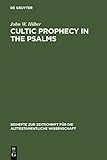Cultic Prophecy in the Psalms / John W. Hilber.
Material type: TextSeries: Beihefte zur Zeitschrift für die alttestamentliche Wissenschaft ; 352Publisher: Berlin ; Boston : De Gruyter, [2012]Copyright date: ©2005Description: 1 online resource (268 p.)Content type:
TextSeries: Beihefte zur Zeitschrift für die alttestamentliche Wissenschaft ; 352Publisher: Berlin ; Boston : De Gruyter, [2012]Copyright date: ©2005Description: 1 online resource (268 p.)Content type: - 9783110184402
- 9783110912739
- 220
- BS1430.52 .H55 2005
- online - DeGruyter
- Issued also in print.
| Item type | Current library | Call number | URL | Status | Notes | Barcode | |
|---|---|---|---|---|---|---|---|
 eBook
eBook
|
Biblioteca "Angelicum" Pont. Univ. S.Tommaso d'Aquino Nuvola online | online - DeGruyter (Browse shelf(Opens below)) | Online access | Not for loan (Accesso limitato) | Accesso per gli utenti autorizzati / Access for authorized users | (dgr)9783110912739 |
Browsing Biblioteca "Angelicum" Pont. Univ. S.Tommaso d'Aquino shelves, Shelving location: Nuvola online Close shelf browser (Hides shelf browser)

|

|

|

|

|

|

|
||
| online - DeGruyter Übungen im Strafrecht / | online - DeGruyter Grundkurs Strafrecht : Die einzelnen Delikte / | online - DeGruyter Democrito e l'Accademia : Studi sulla trasmissione dell'atomismo antico da Aristotele a Simplicio / | online - DeGruyter Cultic Prophecy in the Psalms / | online - DeGruyter Poets Laureate in the Holy Roman Empire : A Bio-bibliographical Handbook / | online - DeGruyter Ideal und Ironie : Baudelaires Ästhetik der "modernité" im Wandel vom Vers- zum Prosagedicht / | online - DeGruyter Transformationen der Lebenswelt – Metamorphosen der Romanwelt: Anatole Frances frühes Romanwerk (1879–1895) : Ein Beitrag zur intertextuellen Erzählforschung / |
Dissertation University of Cambridge 2004.
i-iv -- Acknowledgments -- Contents -- Abbreviations -- Chapter 1: Cultic Prophecy in the Psalms: Issues Past and Present -- Chapter 2: Assyrian Cultic Prophecy -- Chapter 3: Royal Psalms -- Chapter 4: Asaphite Psalms -- Chapter 5: Laments, Hymns and Songs of Confidence -- Chapter 6: Conclusion -- Bibliography -- Index of Texts -- Index of Authors
restricted access online access with authorization star
http://purl.org/coar/access_right/c_16ec
Der Beitrag kultprophetischer Rede zur Entstehung der Psalmen wird stets diskutiert. Viele Erklärungsmodelle lassen außerbiblische Parallelen außer Acht. Dagegen zeigen assyrische Kultorakel Charakteristika prophetischer Rede, die auch in den Psalmen vorkommen, sowie Kompositions- und Aufführungsszenarien, die für eine Vereinbarkeit von Prophetie und Psalmgesang sprechen. Die beste Erklärung für die Entstehung von Psalmen, die eine Gottesrede enthalten, ist weiterhin ein kultprophetisches Modell.
Doubts about the contribution of cult-prophetic speech to psalmody remain in debate. Psalms containing first-person divine speech exhibit numerous features and suggest life settings that conform to actual prophetic speech. Alternative explanations lack comparable examples external to psalms. On the other hand, Assyrian cultic prophecies parallel the characteristics of prophetic speech found in psalms. The Assyrian sources support possible composition and performance scenarios that overcome objections raised against the compatibility of genuine prophecy with psalmody. A model of cultic prophecy remains the best explanation for the origin of psalms containing first-person divine speech.
Issued also in print.
Mode of access: Internet via World Wide Web.
In English.
Description based on online resource; title from PDF title page (publisher's Web site, viewed 28. Feb 2023)


